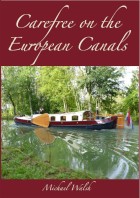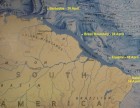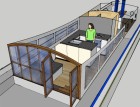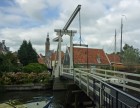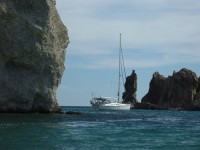Sequitur
Michael & Edi have headed out on a slow, thorough exploration of the globe.
| Vessel Name: | Sequitur and Zonder Zorg |
| Vessel Make/Model: | 2007 Hunter 49 and 1908 Wildschut Skûtsje |
| Hailing Port: | Vancouver, Canada |
| Crew: | Michael Walsh & Edi Gelin |
| About: | For our current location click, on Map & Tracking, then on the Google Earth logo. |
| Extra: | Follow us on Twitter: Follow @YachtSequitur |
| Social: |
13 January 2014
Another New Book Released
I am delighted to announce that my new book: Carefree on the European Canals is now in print and is available on Amazon.com, Amazon.ca [...]
26 April 2013
New Book Released
The proof copy of my new book arrived by courier today. I have approved it and it is now listed on Amazon for pre-order, with a publication date of 30 April. It is a rather large book at 680 pages in an 8.5 by 11 inch format with 315,000 words illustrated by over 2400 colour photos, charts and maps. [...]
24 April 2013
One Year Out of Brazil
One year ago today we sailed Sequitur out of Brazil after enduring more than six weeks in the least-friendly country that we had experienced during our three-year voyage. In the early evening of 24 April 2012 we crossed the line on the chart dividing Brazil from French Guyana and breathed a huge sigh [...]
27 October 2012 | Harlingen, Friesland
Planing a Metamorphosis
We have added a new post to the Zonder Zorg blog at: Planing a Metamorphosis.
29 September 2012 | Sneek, Netherlands
Onward to Friesland
We have arrived in Friesland and have added a new post to the skûtsje's blog at: Onward to Friesland
19 September 2012 | Hoorn, Netherlands
North From Aalsmeer
We have moved northward from Aalsmeer and I have added two new posts: Heading North From Aalsmeer and North From Amsterdam
13 September 2012 | Aalsmeer, Netherlands
Taking Possession
We are back in the Netherlands, and I have added some new posts to the ZonderZorg blog at: Taking Possession and Settling-In and Making Plans
20 August 2012 | Sequitur: St Augustine, USA - Michael & Edi: Vancouver, Canada - Nieuwe Zorg: Aalsmeer, Netherlands
Added a New Website
We have added a new website: Skûtsje ZonderZorg. Zonder zorg in Dutch means without worry. Our intention with the site is to provide a place to share some of the history, geography and culture of the skûtsje as we discover it. We will also use this place to document [...]
11 August 2012 | Sequitur: St Augustine, USA - Michael & Edi: Vancouver, Canada - Nieuwe Zorg: Aalsmeer, Netherlands
Still More Skûtsje History
We continued to attempt to track-down Douwe Albert Visser, who was the owner of Nieuwe Zorg in 1941 when she was re-registered. One of the problems we repeatedly encountered in our online searches was the effect of currently having Albert Visser and two Douwe Vissers as very competitive skûtsje racers, [...]
10 August 2012 | Sequitur: St Augustine, USA - Michael & Edi: Vancouver, Canada - Nieuwe Zorg: Aalsmeer, Netherlands
Some More Skûtsje History
While I was researching the history of Nieuwe Zorg, I finally found her first registration details obscured by an apparent typographical error in a transcribed online spreadsheet. She was listed as having been built in 1901 instead of 1908. I emailed the webmaster of the [...]
Passage to Antofagasta
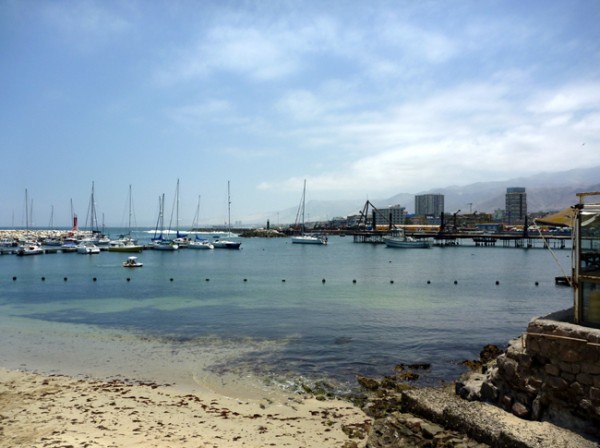
When we awoke, we began thinking of continuing southward. We needed to re-stock our fridges with fresh produce and dairy goods, and lay-in a new supply of lunch and snack items. Also there was room in the freezer for more fish and another batch of bread. Our third propane bottle had expired on Boxing Day, and we were cooking on our last one; we needed to refill the three empties.

On Monday we puttered on board, recharging our internal batteries, then on Tuesday we went shopping. We hailed a collectivo to Supermercado Lider for 2000 Pesos. There we roamed all of the aisles, having the merchandise remind us what we needed, and allowing it from time to time to inspire us.

We then loaded our cart with fresh items. Among these were some superb oyster mushrooms at a stupidly low price, and finally some decent black olives. They were not as nice as our favourite Moroccans from Parthenon in Vancouver, but they were head-and-shoulders above the rancid blacks we had tasted in Peru. We bought two kilos and Edi pitted them when we arrived back onboard.

The high tide we required to exit the marina was around 0300 and 1530 on Tuesday, 0400 and 1630 on Wednesday and 0500 and 1730 on Thursday. We decided to slip from the float on Wednesday's afternoon tide and lie to anchor overnight for an early Thursday departure. After breakfast on Wednesday I went to the Yacht Club office to settle our mooring account and to get details on refilling our propane tanks. The Club Manager, Patricio Vargas gladly accepted our 187,500 Pesos ($375) for the fifteen days we had been alongside.

He also introduced me to his wife, Graciela, a taxi driver who was to take me and the three empty propane tanks to the refilling depot and bring me back. She spoke virtually no English, so we shared a delightful pantomime interspersed with my few Spanish and her few English words. The three-quarter-hour trip cost 3,000 Pesos, $6.

In the late morning Edi and I took the wheelie and went to buy sparkling water. We find it so refreshing while sailing, and rotate a stock through the fridges. From a small supermarket we picked-up a six-pack of 2.5-litre and a twelve-pack of 625s. We wheeled them back past the street-side fish stalls and stopped at the fishmonger we had previously used. His eyes lit-up when he recognized us, and he hollered to his cohorts that 'his' Canadians were back. We selected a 5-kilo male mahi-mahi, and the monger cleaned and filleted it for us.

On our way back to Sequitur, we stopped at the offices of the port authority to do the necessary paperwork to depart Iquique. We explained that we would be leaving the marina on the afternoon tide and anchoring in the bay overnight, for an early-morning departure on Thursday.

The young Able Seaman clerk seemed a bit lost in how to process us, but a bright young bosun Leading Seaman helped him through the process. When the paper work had been generated, we were told that a boat would come to Sequitur in the anchorage at 0900 the next morning to issue our zarpe.
We topped-up our tanks with water from the marina floats, and then had a complex, but uneventful slip from our Med-mooring. We undid our chafing strops on the float cleats, looped the stern lines back onboard, eased them as we shortened-in the anchor cable and once the stern was clear of the finger, let go and hauled-in lines. As we were weighing, the anchor cable brought-up a welded-together grid of rebar with lines attached. It looked like an old, disused mooring anchor. I freed it and continued to weigh, and once the anchor was visible and free of fouling, Edi slowly motored Sequitur onto and along the transit that led us through the narrow, shallow channel. At 1648 we came to 20 metres on the Rocna in 6 metres of water, set the starboard snubber and shut-down.
I sorted the mahi-mahi into meal-sized freezer bags and stacked them into the freezer. I hauled-out the frozen backbones of our previous mahi-mahi and with the new backbone, some celery, onions, garlic, carrots and potatoes, among other things, made-up a large fish chowder. This was put into two one-litre Lock & Lock containers; one for the freezer and the other in the fridge for the first night's meal on our passage.
Thursday's 0900 came and went with no visit from the authorities; so did 1000. I radioed to find-out what was happening, and eventually received a reply that I needed to report to the office and pay the departure fees. Trying to gain some sympathy and save unlashing and launching the dinghy, and then slinging, lowering and mounting its motor, I explained that our dinghy and motor were secured for sea, and that it was a long and difficult process to use it to head in. I asked if they could send a launch to pick me up. They said their boats were busy at the moment, rescuing some surfers overcome in the unusually high seas, but that sometime around 1400 they could come and get me.

Toward 1530 I was picked-up and taken in to the offices of the Gobernacion Maritima. On the way in we passed one of the un-muffled workboats from the fishing fleet. The shrill roar of these workboats pierces the otherwise noisy clamour of the working waterfront, making it seem quietly peaceful in comparison.
The money-taking ladies were back on duty in the offices, and one of them explained to me that the seamen the previous day didn't know that foreign yachts had to pay an exit fee. She asked me for US47.41. I asked why she wanted US dollars, a currency which continues to demonstrate that it is one of the world's less stable. She mumbled something about foreign yachts and I lost track of her thoughts as she apparently did also.
I told her I had no US currency, and offered to pay in Chilean Pesos. She said the exchange rate was very unstable and she couldn't predict what value she would get for them. I told her the Chilean Peso is stable; it is the US dollar that is being jerked around. To save my walk across town to a moneychanger and pay their fees, I eventually convinced her to take 25,000 Pesos. By the time our zarpe was issued, it was approaching 1700, and by the time I was motored back out to Sequitur, it was well past that hour. We decided to remain at anchor overnight and leave early the next morning.

At 0809 on the 14th we weighed and proceeded under power out of Bahia de Iquique. We reported our departure to Port Control, and quickly received an acknowledgement. Once we had cleared the headlands and bent our course southward, the breeze strengthened, and at 0936 we hauled-out a full main, staysail and jib, and set-off on a port tack making 4 knots to the southwest in the 8 to 10 knot southerly breeze. The coast is very drab, with absolutely barren slopes leading up to the world's driest desert. We watched as small, low and fluffy cumulus formed a short distance offshore and quickly dissipated as they reached the land.
In the late afternoon the breeze had decreased to less than 5 knots and we were down to just over 2 knots, but with the north-bound Humboldt Current, our southwesterly heading was being converted into a track much closer to west. We flashed-up and hauled-in all but a stabilizing blade of the main to help counter the 3-metre southwest swells, and we motored south. While the sun set as a flattened oval into a clear, haze-free horizon, we enjoyed the fresh mahi-mahi chowder for dinner. We motored through the night.
At 0711 on 15 Jan, the sun crossed our latitude on its way north. When it rose four minutes later, it was as close to due east as I will likely ever witness at sea. The last time the sun had passed us going north was on 27 April on our third day out from Acapulco to the Galapagos. If things go according to our current plans, Sequitur will now remain south of the sun for the next couple of years.
At 1110 on Saturday we again found some movement in the air, and we hauled-out the main and jib. As the breeze grew to south 10 to 12 knots, we sailed on a starboard tack back in toward the land, making 135 at about 5 knots. In the next five hours we made just over 30 miles, as the wind grew through the mid-afternoon, and then decreased. At 1620 we were ghosting along with the sails slatting as the winds died. We rolled-in the sails and began motoring.
Instead of turning south along the coast, we continued southeast. Ahead of us some 15 miles distant was the port of Tocopillo, and with the thoughts of another night of motoring, it was too inviting to resist. Between 1700 and 1705 I radioed Tocopillo Port Control three times to report our intention of anchoring-in-transit overnight, but received no response. I continued this every hour until our calls finally received a reply.
The sun went down at 2030, and 20 minutes later, with a large waxing gibbous moon over our shoulders, we came to 55 metres on the Rocna in 13 metres of water 3 cables off the crashing surf. There was a large surge in the anchorage, but Sequitur rode it well. I reported our arrival to Port Control, and we were welcomed to Tocopillo.

I prepared two heavily-loaded oven-sized pizzas and by 2130 we were eating our way through the first one with a bottle of 2009 Las Moras Malbec, as the second one baked. We started into the second pizza, and left the rest of it for the next day's lunch. We enjoyed a wonderful sleep, lulled by the surge in the anchorage.

In the morning as I went on deck to prepare for weighing, I had a better view of our surroundings than we had had on our arrival in the dusk and moonlight. We were anchored next to some the very colourful boats of the local fishing fleet.

In the water all around Sequitur were many hundreds of large, multi-coloured jellyfish. The close-in scene was very pretty; however ashore it was not so picturesque.

Tocopillo is a described as an ugly little city, whose main claim to fame are its huge thermo-electric plants, which generate electricity for the mining communities and mines far inland in the Atacama. Among these is Chuquicamata, one of the world's largest open-pit mines, which until recently was the world's largest single source of copper. The title is now held by Mina Escondida some 250 kilometres to the south, with an annual production of 570,000 tonnes.

At 1025 we weighed and proceeded under power in glassy-calm seas, on which every few minutes some small ripples falsely announced the coming of a breeze. As we motored past the entrance lighthouse, I finally figured-out why there is an obscured sector in its arc of visibility. The light is on the northernmost of the two guano-covered islets at the right side of this photo, and is obviously obscured by the higher islet to its southwest.

On the chart the narrow obscured sector seems to me to be in an inopportune place. Was the light placed on the wrong island? If not, was it simply built too low? We continued motoring in glassy seas through the remainder of the day and into the night, making an average of 3.5 knots into the Humboldt Current.

An hour or so after sunset on Sunday, while I was below preparing to wok some prawns in ginger, garlic, oyster mushrooms, three colours of peppers, and other goodies, Edi reported the chart plotter was giving a "Lost Position Fix" error message, and that the ship's position was skewing across the chart. Then the ship's icon disappeared, as did the icons of the AIS contacts.

This continued intermittently for nearly an hour, and then it seemed to correct itself. This has happened previously a few of times, the first time only a couple of months after I had taken delivery of Sequitur in 2007. I had reported this first incident to the installers of the system when I returned to Vancouver, and had been told it was only a general GPG system anomaly.
On Sunday night I had my iPad with its Navionics program switched on, and its GPS showed no problem with keeping a fix; there was no "general GPG system anomaly". I now suspect that our infamous Vancouver installers had made an intermittently poor connection between the GPS antenna and the plotter.

Sunrise on Monday found us still motoring southward in near windless conditions, bucking against the current. At 1231 we crossed the Tropic of Capricorn, and Sequitur was finally out of the tropics after eleven months. A breeze was beginning to fill from the south, and by 1300 it was blowing 12 to 14 knots and building. I rolled-out two-thirds of the main and the whole jib and we took off at better than 6 knots close-hauled on the starboard tack, pointing about 20 degrees above Punta Tetas.

At 1400 we were 272 Faro Punta Tetas 1.3 miles making good a course of 133 the past hour. We appeared to be on a course to clear the crud off the point by 3 or 4 cables. Ten minutes later, a combination wind shift and current change around the point swung Sequitur in toward the point. We were 2 to 3 cables off and closing at over 6 knots. In 2 to 3 minutes we would be on the rocks. Not good!

I quickly tacked a nice tight 90 degrees, but watched as the current took our track around nearly 180 degrees as we clawed off the point. I had been closely monitoring the slowly broadening clearing bearing on the lighthouse as we approached Punta Tetas, and was ready for evasive action if needed. The change of course in toward the rocks had come very suddenly, but within a minute we had tacked. I was glad that years of naval navigation training and experience had taught me to never be complacent. After 15 minutes we tacked back to our southeasterly course toward Antofagasta.
At 1515, when we were 12 miles off the port limits, I called Antofagasta Port Control and reported our position and ETA. At 1600 I eased the sails and came to a beam reach eastward to the port. This was the first time we have had the wind anywhere but on our bows in over eight months. We continued along on a beam reach and then a broad reach until 1805 when we rolled-in the sails and flashed-up the engine.

A dinghy approached Sequitur and the occupant motioned for us to follow him through the channel. We motored in his track as he led the way in a slightly winding unmarked channel, through the surf and past a breakwater into the marina of the Antofagasta Yacht Club and onto fore and aft moorings.

We were moored in a calm harbour just off the remains of the old wharf originally built for the loading of saltpetre. It is said to be the only remaining wharf from the beginnings of the nitrate boom. The wharf was used by the Chilean Armada when they landed troops to take the city in 1879.

Once we had secured, Teo introduced himself and welcomed us to Antofagasta and to the Yacht Club. He gave us the lay of the land and the location of important facilities. The Yacht Club is in the heart of the historic downtown, and sits between two large and modern shopping malls, two and five blocks away.

On Tuesday morning I launched the dinghy, and in the early afternoon we rowed the 30 metres or so to the end of the closest Yacht Club float, and walked ashore to look for the administration office, so that we could register. We didn't find it, but in our search, we did find the Yacht Club Restaurant. The smells were overpowering, and we went in to see a very elegant dining room with no patrons, but lots of scurrying waiters.

We were taken to an outer room, which was crowded with diners ranged along the windows overlooking the marina. We had a superb lunch, starting with shared entrées of scallops in parmigiano and prawns in garlic butter. For main course we each had fresh grouper grilled and smothered in a shellfish laden creamy wine sauce.

We asked our waiter for directions to the administration office and it was still closed for lunch when we arrived at its door. We walked out through the gates and along in the direction indicated to us for the offices of the Capitan de Puerto. Along the way we admired a slab-sided building that had been masterfully transformed with creative tromp l'oiel.

From life-like painted pigeons on illusions of balconies to images of external plumbing mingling with the real stuff, and a view down a non-existent street to clouds matching the real ones, it is a work of art that plays many tricks on the eyes.
We couldn't find the Port Captain's office, so instead we went shopping in the huge Tottus supermarket. Sequitur's pantry and fridges are full again, and we are in a very clean, peaceful and friendly port. We have decided to stay for a few days more.

